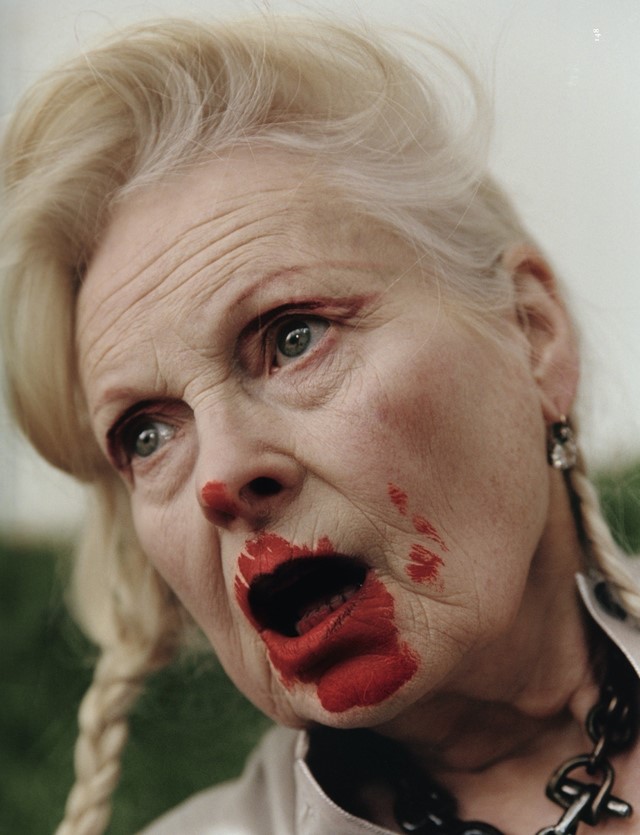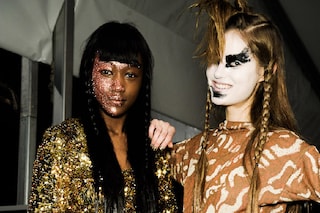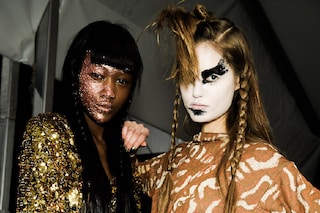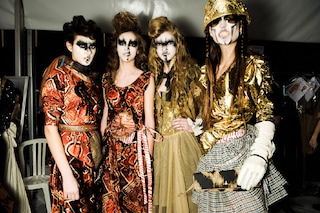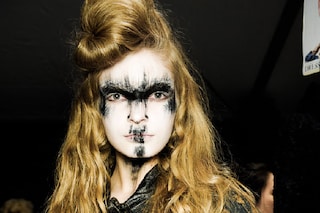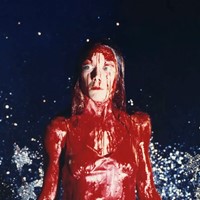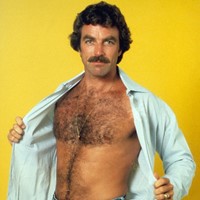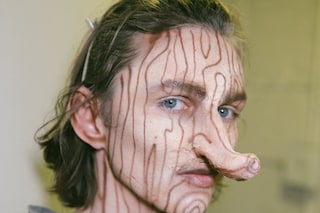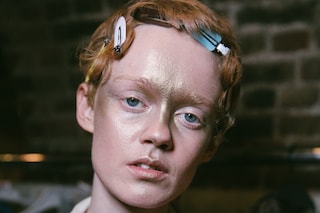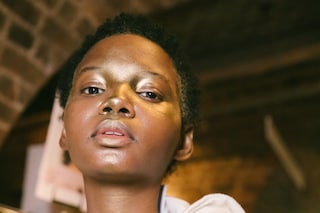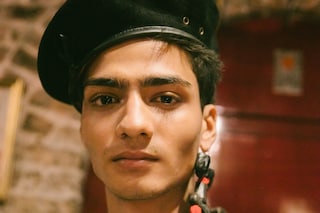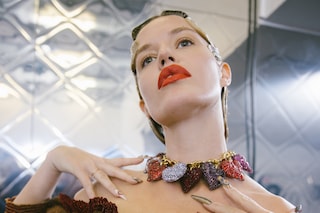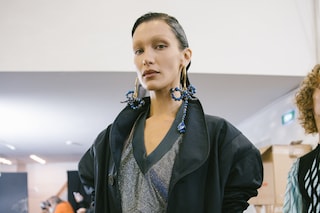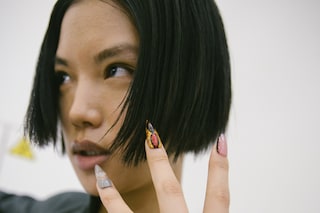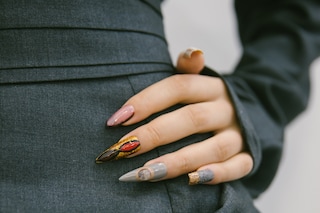Beauty creatives including Val Garland and Isamaya Ffrench break down the make-up and hair looks they have created for the legendary, late designer from Pinocchio noses to models eating coal
“Punk feels very heroic,” Vivienne Westwood said in 2017. “When I say heroic, I mean to express individuality. That’s what it is, to be known in a crowd and forcefully expressing individuality.” There’s no doubt that the legendary designer, who died yesterday at 81, expressed individuality in every aspect of her life and work. Individuality, provocation and a punk sensibility were the cornerstones of Westwood’s art throughout her five decades in the fashion industry, as she imbued everything she did with an anti-establishment spirit – even when being honoured with an OBE by the Queen. Never allowing her subversive, rebellious edges to be smoothed down by time, success or the luxury of the industry, she continued fighting up until the end, from driving a tank to David Cameron’s house in 2015 to protest fracking to using her runway shows to deliver powerful messages on the climate crisis.
When it came to beauty, the audience at a Vivienne Westwood show could expect looks that, whether smeared or pristine, historically-influenced or forward-looking, Pinocchio noses or Kate Moss in an oversized septum ring, were unexpected. Make-up artist Val Garland, a longtime collaborator, described the look as childlike and bonkers. “It always feels like [the models] could’ve done it themselves really,” she told AnOther in 2017. “It always feels like kids in their mum’s dressing room playing with her lipstick. We have fun with it, we don’t take ourselves too seriously.”
Although she professed to a low-maintenance beauty routine herself – when asked once the secret to her youthful appearance Westwood replied, “don’t wash too much” – she was always recognisable thanks to her punk appearance, from the spikey blond hair of the early King’s Road days to the signature electric orange of her later years, the pale skin and charmingly dishevelled make-up. In 2014, at age 72, she shaved her head in an environmental protest, an act that exemplified her political approach to beauty. “I’ve constantly tried to provoke people into thinking afresh and for themselves, to escape their inhibitions and programming,” as she explained in the show notes to the V&A’s 2004 exhibition, Vivienne Westwood: 30 Years in Fashion.
To mark the passing of Westwood, we revisit some of her key beauty moments on the runway over the years and hear from the creative teams behind the looks, in their own words, the concept, inspirations and what working with the designer was really like.
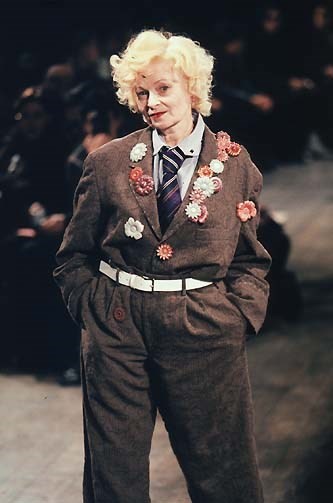
1980s and 1990s
In 1981, Westwood and Malcom McLaren staged their first runway show at the Pillar Hall in Olympia for an audience that included Adam Ant and Mick Jagger. Known as the Pirates collection, the unisex offerings were inspired by the clothes of highwaymen, dandies, buccaneers and pirates. In these early days, a DIY spirit suffused all aspects of the show, and models chose their own clothes, shoes and their own mismatched hairstyles.
By the 90s, the hair and make-up were more professional, although the names of the team have been lost to time even by Westwood’s own archive team. For the iconic SS96 Cafe Society show, models including Kate Moss walked the runway topless eating Magnums with Elizabethan era hairstyles and white powdered faces. Saffron eyeshadow contrasted berry-hued lips, and many models also wore fake, dark beauty spots on their cheeks.
“As with the clothing, the same emphasis on satire and breaking down historical conventions was applied to the hair and make-up,” wrote Kristen Bateman in her retrospective of the show. “By reappropriating the very traditional make-up and hairstyles of the Elizabethan era and placing them on the top supermodels in the world during the 1990s who for the most part are all wearing provocative clothing, she created something entirely new and shocking.”
2000s
In 2006, Westwood started working with make-up artist Val Garland who had become a creative provocateur in her own right thanks to her work with designers like Lee McQueen and John Galliano. It was the beginning of a years-long collaborative partnership, alongside hair stylist Sam McKnight, although Garland says the first time they worked together it didn’t go smoothly.
“Just before the show Vivienne came along and went, ‘Oh no, no, no that’s far too perfect, no, no, no,’ and kind of rubbed lots of the make-up off. She left it a bit mucky and I didn’t think I’d get booked again,” Garland recalled in a 2017 interview for AnOther magazine. “I thought ‘Well she obviously didn’t like what I did, probably because it was too normal, it was too ‘make-up-y’, it was too nice.’”
Despite that, Garland was booked again and this time she went in with a different approach, deciding to be more childlike, painterly and ‘a lot rougher’. Westwood loved it. “You know I always walk into a Westwood fitting and think that if it’s wrong, then it’s probably right, if it looks like, ‘Oh I don’t know if that’s going to work’, then it’s probably the right thing to do and that’s how I do it.”
A perfect example of the painterly, spontaneous style favoured by Westwood was the AW08 show where the make-up look was that of an eco-hippy full of hand-painted butterflies, swirls and abstract splashes of colour. “The make-up looked like it had been done by a child too, and one with non-too-steady a hand. The audience were clearly baffled - some booed, some applauded,” the Guardian wrote at the time.
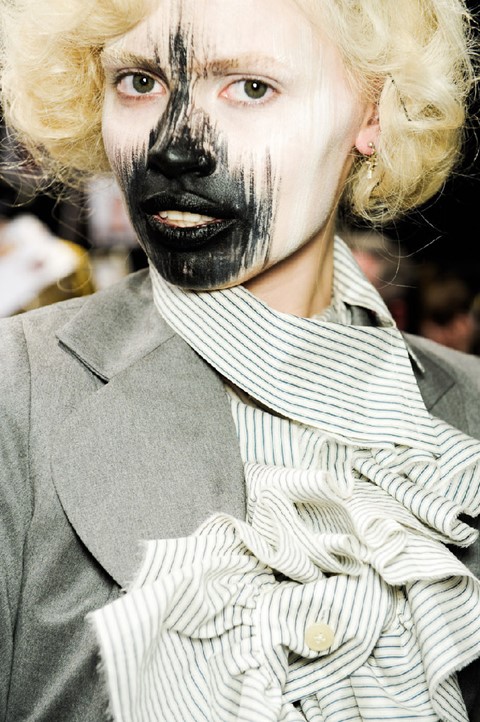
2010s
Westwood’s all-time favourite beauty look from her shows came in the Gold Label SS11 Horses presentation. “The look was incredibly strong, there was one moment when it appeared like the model had been eating coal. I wasn’t sure if Vivienne was going to like the make-up,” Garland told Dazed in 2019. With their white painted faces and black across the eyes and lips, the models look variously like they had been eating coal, had been run over or were in a Kiss tribute band.
“‘Horses’, she just said, ‘horses’ and I waited, and waited, and waited, and not another word was uttered and off she went. So I went back to my team and I’m like ‘She just said horses’,” Garland recalled of the concept she was given for the make-up. “I’m like ‘OK, let’s get up some images of horses, let’s look at the markings, let’s look at their pelts, let’s look at the colouration on their fur,’ and so I said ‘OK, that’s what we’re going to do: we are only going to use one colour, it’s going to be black, all the make-up is going to be black and it’s going to be kind of a zebra – which is a form of horse. A zebra sort of marking and we’re just going to do different facial markings.’”
A similar dark, painterly look was used for the Red Label SS14 show where Garland used a feather to apply intricate black ink illustrations to the faces of the models, whilst others were smeared in black, blue and red paint. SS15 saw a child-like sensibility, with Kubrick lashes, velvet eyebrows, and red lips described by Isabella Burley as “smudged with lines that appeared to be drawn on by pre-teen girls”, while the following year saw warpaint smeared over the eyes.
For AW19, Westwood turned to Isamaya Ffrench to recreate striking beauty looks that reinforced the message of political protest for the presentation which touched on everything from global warming and sustainability to austerity and Brexit. Models with prosthetic Pinocchio noses shouted messages like “tax the poor and give to the rich, that’s the lie with the long nose”, while others were plastered with brightly coloured balloons and faces covered in gold spray paint. Meanwhile, hair courtesy of Gary Gill was wild and untamed.
2020s
For her first show of this decade, Westwood continued to use her label as a vehicle for political messages. SS20 eschewed the catwalk and instead showed the collection digitally with a lookbook and short film in which the designer discusses how rotten financial systems are the source of poverty and climate change.
The collection itself was inspired by Commedia dell’Arte, the comedy popular in 16th-18th century Italy based on stock characters including Pierrot, a sad clown, and Harlequin, a comic servant. It was these theatrical conventions which also informed the beauty looks masterminded by Ffrench and Alex Brownsell, who took the traditional masks as their starting point.
“It’s always very organic when working with Vivienne. We look at some references and inspiration images together and then use them to create a look for the models,” said Ffrench about the creative process. “She is so straightforward. We test and we experiment, but Vivienne is always very direct and knowing of what she wants. It’s an artistic process that we are all able to share in.”
Brownsell said she was surprised by how involved Westwood was in every little aspect of the collection and shoot. “I have huge respect for Vivienne and what she's achieved in her career, she is a legend and it’s an amazing opportunity to have worked with her.”
For SS23, the final show under the Vivienne Westwood label before she died, Ffrench and hairstylist Charlie Le Mindu – who yesterday posted in tribute to Westwood a video of the tattoo of her signature he has on his ass – looked to the 1920s for inspiration. Slick, almost greasy, finger curls featured heavily for hair, alongside one model who wore a mohawk, while Ffrench used her own brand to block brows and draw on the skinny brows that have made such a comeback this year.
